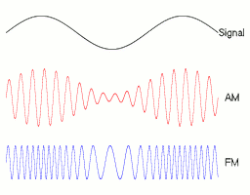
It makes sense to build a transmission tower to be as tall as possible, as this would reduce any interference that would otherwise block the radiowaves. This can be taken to the extreme with especially tall structures, such as the Warsaw Radio Mast (not actually in Warsaw), which began operation in 1974 and stood at an impressive 646m, making it then the tallest structure ever built. With this structure, anyone could listen to Program I "Jedynka" and when I say anyone, I mean people living as far as the US and Kazakhstan could access it. The mast collapsed in 1991 whilst being maintained, but that's beside the point and proves how important radio has been in communication.
Why could the Warsaw Radio Mast transmit radio signals so far? Because those signals were longwave, that's why. Radio waves in general can be classified as either AM or FM signals. AM (short for amplitude modulation) is where the radio signal's amplitude is altered, and is the oldest form of radio broadcasting, having been around since the turn of the 20th century. FM (short for frequency modulation) is where the radio signal's frequency is adjusted, and was invented in 1933 by Edwin Armstrong, and is the more recognised one. AM waves have a lower frequency than FM waves, but have a much longer wavelength than FM waves. This in turn causes AM signals to have a lower fidelity than FM signals, which in turn causes it to be more susceptible to static.

In terms of broadcasting, FM radio has slowly been replacing AM radio in terms of market share, and whilst the demand is still there for AM radio, its lack of quality means that it's only truly suitable for broadcasting talk radio or the news, as this can reach a greater audience over a large area. In turn, AM isn't particularly suitable for playing music, because the longer waves make them more susceptible to being blocked off by obstacles such as trees or tunnels. This doesn't stop radio stations from playing music on AM radio, but some have decided to stop. As the blog also highlights, broadcasting on an AM signal is very costly, so if no one's listening, why bother? It's more beneficial to broadcast on the format that is default on cars as well as being better (yet Absolute Radio also don't broadcast on FM radio anyways).
AM radio waves can further be split up into three different types of wave - longwave (LW), mediumwave (MW) and shortwave (SW). As their names suggest, longwave has the longest wavelength, varying from 10-100km (hence the figure at the start), followed by mediumwave (at 1-10km) and shortwave (0.1-1km). In return, longwave broadcasts at the lowest frequencies (around 30-300 kHz), whilst shortwave broadcasts at the highest frequencies (3-30 MHz). The waves broadcast by the Warsaw Radio Mast were longwave, for instance, as are many radio stations such as the British station BBC Radio 4, whilst shortwave broadcasts have recently started to decline in broadcasting, though they remain somewhat popular in countries that lack infrastructure to support FM radio, and the BBC started SW broadcasts in Russia and Ukraine after the Russian invasion of Ukraine last year in Russia. Indeed, SW seems to have reached its peak during the Cold War, not least as there would be a decreased chance of any signals being jammed due to such a high frequency. AM radio is also used in aircraft as well as amongst ham radio enthusiasts, whilst being supported to this day - stations such as Radio 4 are arguably providing a more beneficial service if being broadcast to remote communities that might really need to hear The Archers and the Shipping Forecast, unlike FM radio where signals travel across a shorter range.
FM radiowaves are at the higher range of frequencies - in the UK, FM radio stations are broadcast at frequencies ranging from 87.5 MHz to 108 MHz, which appears to be the common range used across the world (some countries like Japan use 76-95 MHz). Frequencies are usually assigned every multiple of 100kHz so to not cause any interference between adjacent stations, yet the allocation of stations varies depending on which country you're in. The UK allows both even and odd multiples of 100kHz; the Philippines only allows odd multiples; Italy goes for multiples of 50kHz; it's a mess.
That's the physics. But let's briefly talk about something more abstract and confusing - what is the future of AM and FM radio?
Sadly, their days are (maybe) numbered. Norway switched off their FM broadcasts back in 2017, and all radio has started to transition to digital, barring some local stations. Switzerland's planning to do the same in 2024. I somewhat doubt that AM and FM would go away forever, though - digital radio requires one to have a dedicated radio that can broadcast those stations, and there will always be people living in remote communities that simply wouldn't be able to afford one and to whom AM is simply more convenient. That said, lots of the world has already said goodbye to analogue TV and digital is commonplace, so maybe my concerns are misplaced. And radio itself is on the decline - anyone can listen to music using streaming services, news can be accessed more quickly on social media, services such as Netflix have the entertainment nowadays (even if it's not The Archers)...and let's not forget TV channels and CDs and all the other media that just thirty years ago was used by everybody and now looks increasingly obsolete. It's sad to look at from the perspective of someone with an interest in radio broadcasting, but interesting from the perspective of a regular passerby who could only care if he can listen to what he wants and not what type of signal he's listening on.
Comments
Post a Comment